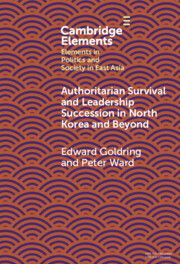Refine search
Actions for selected content:
142 results
14 - After Xi
-
-
- Book:
- The Communist Party of China
- Published online:
- 22 December 2025
- Print publication:
- 22 January 2026, pp 310-330
-
- Chapter
- Export citation
Chapter 12 - Augustine on Time, Eternity, and Temporal Experience
-
-
- Book:
- Augustine's ‘Confessions'
- Published online:
- 16 December 2025
- Print publication:
- 22 January 2026, pp 205-221
-
- Chapter
- Export citation
Chapter 14 - Suárez on Time
- from Part V - Categories
-
-
- Book:
- Suárez's <i>Metaphysical Disputations</i>
- Published online:
- 13 October 2025
- Print publication:
- 30 October 2025, pp 257-276
-
- Chapter
- Export citation
Chapter 4 - Last Wills and Remembrance
-
- Book:
- The Will in English Renaissance Drama
- Published online:
- 04 September 2025
- Print publication:
- 18 September 2025, pp 130-165
-
- Chapter
- Export citation
Empress Dowager Lou the Kingmaker: Succession, Marriage, Identity, and Politics in Northern Qi (550–577)
-
- Journal:
- Journal of Chinese History , First View
- Published online by Cambridge University Press:
- 31 July 2025, pp. 1-33
-
- Article
-
- You have access
- Open access
- HTML
- Export citation
15 - Treaty Law Questions and the Convention
-
- Book:
- Genocide in International Law
- Published online:
- 14 March 2025
- Print publication:
- 03 April 2025, pp 722-786
-
- Chapter
- Export citation
The Hidden Significance and Resilience of the Age-Limit Norm of the Chinese Communist Party
-
- Journal:
- Asia-Pacific Journal / Volume 20 / Issue 19 / December 2022
- Published online by Cambridge University Press:
- 14 March 2025, e1
-
- Article
-
- You have access
- Open access
- Export citation

Authoritarian Survival and Leadership Succession in North Korea and Beyond
-
- Published online:
- 03 February 2025
- Print publication:
- 27 February 2025
-
- Element
- Export citation
5 - Swearing Abū al-Jaysh into Office: The Loyalties of Ṭūlūnid Egypt
- from Part I - Personal ties
-
-
- Book:
- Mechanisms of Social Dependency in the Early Islamic Empire
- Published online:
- 06 December 2024
- Print publication:
- 28 November 2024, pp 150-172
-
- Chapter
-
- You have access
- Open access
- Export citation
Question 10 - The Eternity of God
-
- Book:
- Commentary on Thomas Aquinas's Treatise on the One God
- Published online:
- 23 November 2024
- Print publication:
- 21 November 2024, pp 138-154
-
- Chapter
- Export citation
10 - Mater Castrorum
-
-
- Book:
- Women and the Army in the Roman Empire
- Published online:
- 24 October 2024
- Print publication:
- 07 November 2024, pp 270-298
-
- Chapter
- Export citation
MATRILINEAL SUCCESSION IN GREEK MYTH
-
- Journal:
- The Classical Quarterly / Volume 74 / Issue 1 / May 2024
- Published online by Cambridge University Press:
- 27 May 2024, pp. 1-23
- Print publication:
- May 2024
-
- Article
-
- You have access
- Open access
- HTML
- Export citation
In the Shadows of Great Men: Retired Leaders and Informal Power Constraints in Autocracies
-
- Journal:
- British Journal of Political Science / Volume 54 / Issue 4 / October 2024
- Published online by Cambridge University Press:
- 02 April 2024, pp. 1088-1114
-
- Article
-
- You have access
- Open access
- HTML
- Export citation
The Interplay between Hereditary Traditional Leaders, Democratically Elected Leaders and Succession: A Case Study from Makapanstad, North West Province, South Africa
-
- Journal:
- Journal of African Law / Volume 68 / Issue 2 / June 2024
- Published online by Cambridge University Press:
- 26 February 2024, pp. 203-214
- Print publication:
- June 2024
-
- Article
-
- You have access
- Open access
- HTML
- Export citation
2 - The Crises Leading up to Alexander’s Accession
- from Part I - Alexander’s Life and Career
-
-
- Book:
- The Cambridge Companion to Alexander the Great
- Published online:
- 04 January 2024
- Print publication:
- 18 January 2024, pp 42-54
-
- Chapter
- Export citation
Chapter 5 - On the Knees of the Body Politic: Scottish Succession and English Liberties, 1567–1608
-
- Book:
- England's Insular Imagining
- Published online:
- 28 September 2023
- Print publication:
- 09 November 2023, pp 154-187
-
- Chapter
- Export citation
Invasion by Callery pear (Pyrus calleryana) does not affect understory abundance or diversity in early-successional meadows
-
- Journal:
- Invasive Plant Science and Management / Volume 16 / Issue 4 / December 2023
- Published online by Cambridge University Press:
- 06 November 2023, pp. 215-224
-
- Article
-
- You have access
- Open access
- HTML
- Export citation
2 - Central Concepts
- from Part I - Maintaining Populations of Featured Species: A Utilitarian Approach to Conservation
-
- Book:
- Conservation in the Context of a Changing World
- Published online:
- 28 September 2023
- Print publication:
- 12 October 2023, pp 38-63
-
- Chapter
- Export citation
Hume on the Temporal Priority of Cause Over Effect
-
- Journal:
- Canadian Journal of Philosophy / Volume 53 / Issue 1 / January 2023
- Published online by Cambridge University Press:
- 12 October 2023, pp. 81-94
-
- Article
-
- You have access
- Open access
- HTML
- Export citation
1 - The Rise of Chinggis Khan and the United Empire, 1206–1260
- from Volume I Part 1 - Political History
-
-
- Book:
- The Cambridge History of the Mongol Empire
- Published online:
- 01 January 2024
- Print publication:
- 17 August 2023, pp 19-106
-
- Chapter
- Export citation
